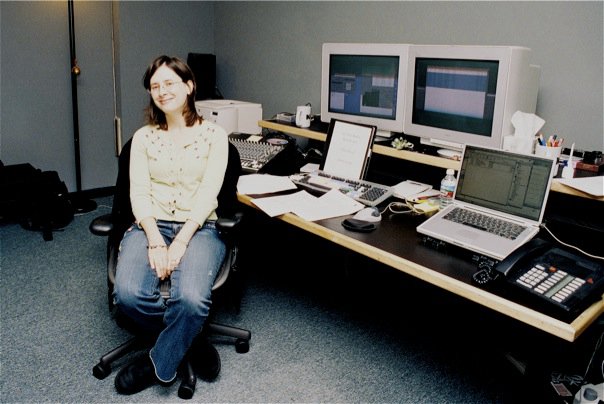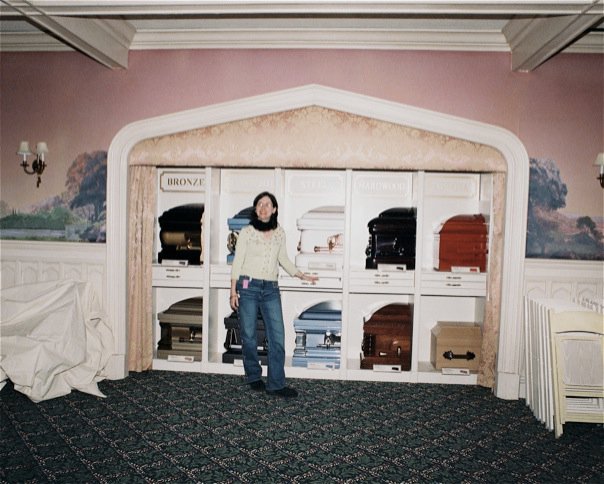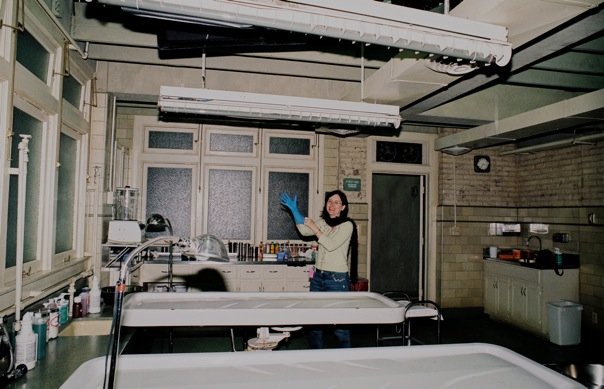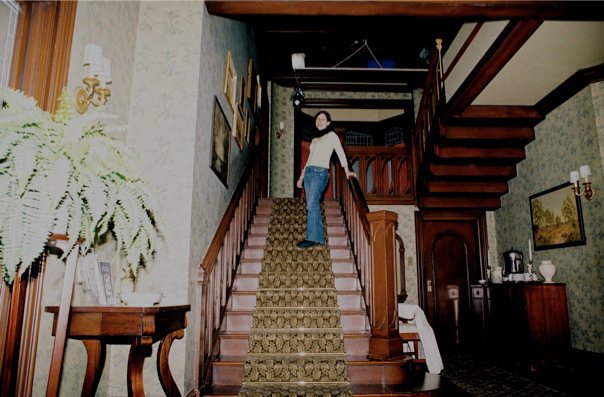
JULIA LEE BARCLAY-MORTON – YOGA, WATER AND REWRITING AUTISM
I interviewed writer Julia Lee Barclay-Morton about her experience of autism. Julia began as an experimental dramatist in New York, moving to the UK to


I interviewed freelance film/TV editor Lisa Willinger about her behind-the-scenes work on Six Feet Under and other cutting-edge TV programmes and films. Lisa’s interview is a big reveal about the pressures of post-production and the creative importance of editing.
Lisa, who is an expert editor, says, “The job is intense, important, demanding, but ultimately very rewarding. Editors put footage together to tell the story in the most compelling way possible and achieve the creative teams’ goals. That often involves adding sound effects, music and visual effects – under extreme time pressure!”
Leslie: Which particular edits have been your most important, rewarding and eye-opening projects? Why them?
Lisa: I assistant edited on films and television series for 10 years, learning the trade by assisting other editors before getting bumped up to editor.
The most rewarding series to work on was Six Feet Under for HBO. It was a fun experience because everyone from the top down was so nice!
Alan Ball, the show’s creator and executive producer, is one of the nicest, most humble men on the planet and his behavior set the tone for everyone else. The other reason the show was so much fun for me to work on was because we edited the show above the sound stages where it was filmed, which made us in the editorial department feel a part of things in a way that you often don’t when shows film out-of-state or out-of-country which is often done to take advantage of favorable currency exchange rates or non-union labor available in so called “Right to Work” states like Georgia or North Carolina.
Also, the script on Six Feet Under dealt with mature themes, and had complexly written, complicated characters, which were other reasons why I consider it the best show I worked on. Each episode opened with a death because the series was set in a funeral parlor, and revolved around the lives of the characters who ran the funeral home.
I had the privilege of assistant editing on the last episode ever, the series finale. As I roughed together the end sequence where we flash forward and see how each major character’s life will unfold, as well as how they will die, I began to cry, even though the sequence was still missing shots. So half of it consisted of title cards I created, saying what was about to happen in the shots that were missing. The reason I found it so moving, I realized, was because it was perfectly conceived and because Alan Ball had picked the perfect song—Sia’s “Breathe Me.” This ending was the perfect ending for this long-running series about life, love and death and that is because of the great script.
As an assistant editor on Six Feet Under I worked for three different editors, all of whom had different editing styles so I learned a lot from them about editing. I also did as much editing of scenes as possible for my editors, whether they asked me to or not, to get their feedback on my editing and I was fortunate in that two of my scenes that I cut made it into the final episode of Six Feet Under exactly as I edited them with no changes!
(Typically an assistant editor is not expected to edit scenes, but rather to handle the technical end of getting footage into the Avid editing system and getting cuts as well as lists for the final onlines (versions that air) out of it. So the job tends to be more organizational and technical then creative, though I always tried to give my editors creative input when they wanted it and place songs in episodes when they wanted my help. Placing songs is a very creative act.)
A few years after “Six Feet” ended I was incredibly lucky to finally get promoted to editor from assistant editor by J.J. Abrams on a series he executive-produced after NINE years of assistant editing.

Leslie: How do you prepare for an edit, and how does the task change/develop as you do it?
Lisa: To prepare as an editor when cutting an episode of scripted television, I read the script and think about what the writer/producers were trying to accomplish when they wrote it. And then I highlight lines of dialogue that I think are the most important and make notes of who I think I should be cutting to at what point in the scene. (The producers also hold what’s called “a tone meeting” before they start shooting with the key crew members, including the editor, to discuss what they hope to see filmed and how they hope to see it edited. I always listened in on these meeting which often occur over the phone but did my own independent analysis and thinking about my task.)
Often I could anticipate ways to improve the script by restructuring scenes and deleting lines, because in network television you are limited to a strict amount of time and a basic format in which you must know what the main conflict is and what the main storyline is by the end of the first act. So if the script has not been written to do that, I know I will be trying to achieve that in the editing room later, after shooting wraps. (Often too, producers turn over a script that is longer than the amount of time that will air so a big part of the film editor’s job is figuring out how to bring the finished episode down to its allotted time by cutting out unnecessary dialogue or action.)
A famous book about editing is called “When the Shooting Stops the Cutting begins” by Ralph Rosenblum. He edited several films for Woody Allen back in the early days of Allen’s career and discusses some of the ways he helped that Director realize his creative vision in the cutting room. I highly recommend it for anyone looking to comprehend this profession.
Leslie: Tell us about the Vampire Diaries.
Lisa: I’d rather not discuss the Vampire Diaries, which was the fourth scripted episodic series I worked as an editor on, because it was not a pleasant experience for me. Unfortunately, after cutting only one episode I was let go for reasons beyond my control. Such experiences are not uncommon in the life of a television editor. Most TV editors have similar stories and in that show’s first season MANY editors got fired.
Nonetheless, I loved what I did for a living. I used to say it was so much fun that I couldn’t believe my good fortune in getting paid to do it. Also, because film/tv editing is a unionized profession it comes with a good wage and great health and pension benefits.
I only wish more Americans had the benefit of belonging to a union. I would like to see my daughter become a professional in one of the unionized trades in the entertainment industry when she grows up if possible—assuming she would like that too.
Most of the editors I assisted had parents who had been actors or producers or writers in the entertainment industry. I did not have that, which is one reason I had to work so hard, and that it took nine years for me to become an editor after breaking in to the business.

Leslie: How did you progress from art and art history to working in media?
Lisa: When I first moved to Los Angeles with a degree in art (concentration in photography) I worked as a photo editor in publishing and later as a Photo sales rep for a stock photo agency that featured high end celebrity portraiture. After print publishing work dried up in LA, I decided to focus on breaking into the film and television industry because I assumed it was the one industry that would never leave Los Angeles and I had discovered that I actually loved living in Southern California!
This turned out to be a somewhat naïve assumption now that so many TV shows and movies are filmed out of state and out of country for economic reasons, but I am not sorry I made that decision.
How I broke in to the business was by assuming that because I had not gone to film school, I needed to work for free, work hard, prove myself with my excellent work ethic, be pleasant/have a good attitude and network relentlessly which I did, though it wasn’t easy for me since I am naturally shy.
However, the first film projects I worked on I did so on set in the art department rather than in editing. And while doing that I discovered that I loved working on a team with a group of people all putting on a show together! The hours were brutal and the pay of these non-union films low, but I have fond memories of standing on the front lawn of a location in Hollywood while the actor Sean Astin entertained us tired crew members by making jokes and telling stories.
You could say that working in the art department of that film called The Low Life showed me the joys of working with other people on a team all putting on a show together at the same time and it lured me out of my shy shell. That experience was a definite life changer for me!
After that experience of working on set in the art department, however, I decided to move into film editing in part because I thought my personality and skillset better suited for editing than art department/production design, and in part because another crew member erroneously told me the hours would not be as LONG in post-production. (On set we often worked 20-hour days.)
He turned out to be WRONG about the hours being shorter in post-production however! (Very wrong as I discovered when I ended up having to spend ALL NIGHT in my cutting room on The Vampire Diaries!)
How I progressed after that was that I worked for free in editing at first, then for minimum wage and then I worked enough days at minimum wage in editing to join a union, the Motion Picture Editors Guild. The Guild does not help you find work but paying the initiation fee and joining the guild enables you to take work on union projects, if you can get your foot in the union job door yourself. I was able to do that over time in part because my husband and I did not have children yet, and our financial needs were few so not working steadily in the beginning was not a hardship. In between assistant editing jobs in the film industry I worked as a legal secretary through a temp agency—work I hated, but which paid the bills.

Leslie: What is the Avid? And what did you learn from working on it?
Lisa: The Avid is a digital (nonlinear) editing system done on a computer. At the time I began assistant editing, movies and TV shows were edited on film, and/or on videotape or on machines that you threaded film on and watched on a screen. But a new technology had been developed, which was digital/nonlinear editing done on a computer just when I was trying to break into the profession.
I decided to learn both digital and analogue—film—editing/assistant editing—simultaneously by taking union subsidized classes on the Avid (then the dominant digital editing system) and I decided to apprentice myself for free on short films which were being edited on film in order to learn the film part of the trade. Luckily, I learned quickly and had generous mentors willing to share their knowledge when I started!
Leslie: How would you describe the role of an editor?
Lisa: I believe a good film editor is always trying to serve the story rather than show off their editing talent with the edits they make.
Understanding the format of the end product you are editing is important so knowing the format or structure of scripted episodic tv series versus a feature film is important, because how you cut the material depends on which platform the end product is going to be seen on.
In a feature film, you generally have 90 minutes to tell a story and the first major story, beat or event needs to occur by the end of the first reel or 20 minutes in—-no later than that or you lose your audience. There’s a famous story in editing circles about the 1994 Harrison Ford film The Fugitive in which the film had previewed very badly before audiences, and one of the editors realized the first major beat which is the bus crash needed to be moved up a lot earlier. However, according to the story I heard, the Director, Andy Davis resisted making that change, so when he got up to use the restroom, the editor quickly did a re-shuffle on the Avid, turning the bus scene into a shorter, faster sequence and changing the order. The result was that it happened by the end of the first reel, about 20 minutes in. When Davis returned to the cutting room the editor was able to show his new version to him and he agreed to move forward with that structure.
The film ultimately became a big hit for the studio, but because of the tight deadline for its release as well as the challenges of restructuring the footage it had FIVE different editors working on it. All of them were fairly large name editors. I later assisted a friend of one of them as well as one of the assistant editors on the film, so I heard the editing story from two different people.
Leslie: You say on Facebook “character and story are my fundamentals.“ How did that idea play out in your job editing films and television?
Lisa: What I meant was the editor serves the story. Her job is to edit the footage together in such a way that the script reaches its fullest expression on the screen, and the producers’ and / or directors’ vision is achieved. The film/TV editor edits film/video footage not words, although a lot of the time what she is editing is footage of characters saying lines of dialogue. So understanding which lines are important to be seen (as opposed to being heard while watching the face the character is speaking to) as well as which lines can be cut out entirely without sacrificing important information, is a huge part of the film Editor’s job. Editing also involves understanding performance and pacing as well as how to use music and sound effects to enhance or create the audience’s emotional reaction as well as the film’s “reality.”
When I edited television, I used to think of my job as playing with dolls for grown-ups because I was moving characters who were saying different lines around much the same way as I used to play with dolls as a little girl. And I also used to say, “I just hope I get to move around attractive, appealing dolls, who are well dressed and say interesting believable lines!”
I doubt many male editors would describe TV editing that way, but it was how I thought of it.
On some episodes of my TV job I wrote offscreen dialogue to help make the story work better. (This is called ADR or “additional dialogue replacement.”) Such dialogue, often written by the film editor in the cutting room (but also written by the writer/producers) and recorded by the actors later in a recording studio, are frequently part of the producers, writers, directors, and editor’s tools.
Until I begin working in Editorial, I didn’t notice such ADR but now, of course, I notice it all the time. In fact, recently, while watching a film I love, Terrence Malick’s Days of Heaven I noticed one scene late in the movie that’s shot from a low angle against a bright sky. It’s of Sam Shepard‘s character, who is almost completely backlit, so you cannot see the details of his face clearly as he speaks lines of dialogue. However, if you look closely you’ll realize that his lips aren’t moving. I worked out that his words must’ve been written after the main shooting stopped. Then the backlit footage of him must have been added later (probably shot in a parking lot) because the Director or the producers felt the story needed the information he delivers in those lines!
I love noticing things like that.
Leslie: Which novels that you’ve read all the best examples of how this idea works what does story characterization and great fiction have to teach people who make films TV programs?
Lisa: Novels and screenplays (which form the basis of films) are vastly different, so I don’t think this question really applies to film editing. There are some great books about the film editing process —one of which I’ve just mentioned “When the shooting stops the cutting begins” by Ralph Rosenblum. Another book I like about the process is Walter Murch’s In the Blink of an Eye.
In that book Murch, who edited Francis Ford Coppola’s The Conversation as well as Anthony Minghella’s The English Patient, describes his editing process beautifully.
So I recommend those books to anyone interested in understanding film editing.
That said, of course great film editors are people who love stories so hopefully they are also readers of great books! (I’ve always been a bookworm and as a kid occasionally tried to create comic book versions—with drawings and dialogue bubbles—of books I loved. And comic books are in many ways like storyboards for movies —in my opinion.)
Next week Adam Farrer, who won the NorthBound Book Award for Cold Fish Soup, talks about writing creative non-fiction.
ABOUT LESLIE TATE’S BOOKS:

I interviewed writer Julia Lee Barclay-Morton about her experience of autism. Julia began as an experimental dramatist in New York, moving to the UK to

I interviewed Gillean McDougall from Glasgow, who edited the collaborative projects Honest Error (on Charles Rennie Mackintosh and his wife Margaret Macdonald) and Writing the

I interviewed French writer Delphine de Vigan, whose book, No et moi, won the prestigious Prix des libraires. Other books of hers have won a clutch

I interviewed Joanne Limburg whose poetry collection Feminismo was shortlisted for the Forward Prize for Best First Collection; another collection, Paraphernalia, was a Poetry Book Society Recommendation. Joanne

I interviewed Katherine Magnoli about The Adventures of KatGirl, her book about a wheelchair heroine, and Katherine’s journey from low self-esteem into authorial/radio success and
| Cookie | Duration | Description |
|---|---|---|
| cookielawinfo-checkbox-analytics | 11 months | This cookie is set by GDPR Cookie Consent plugin. The cookie is used to store the user consent for the cookies in the category "Analytics". |
| cookielawinfo-checkbox-functional | 11 months | The cookie is set by GDPR cookie consent to record the user consent for the cookies in the category "Functional". |
| cookielawinfo-checkbox-necessary | 11 months | This cookie is set by GDPR Cookie Consent plugin. The cookies is used to store the user consent for the cookies in the category "Necessary". |
| cookielawinfo-checkbox-others | 11 months | This cookie is set by GDPR Cookie Consent plugin. The cookie is used to store the user consent for the cookies in the category "Other. |
| cookielawinfo-checkbox-performance | 11 months | This cookie is set by GDPR Cookie Consent plugin. The cookie is used to store the user consent for the cookies in the category "Performance". |
| viewed_cookie_policy | 11 months | The cookie is set by the GDPR Cookie Consent plugin and is used to store whether or not user has consented to the use of cookies. It does not store any personal data. |